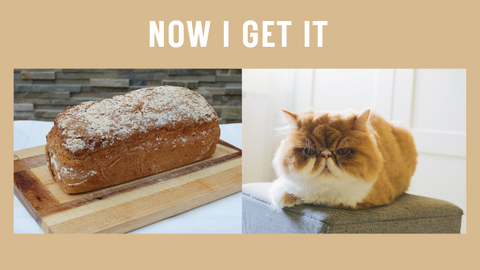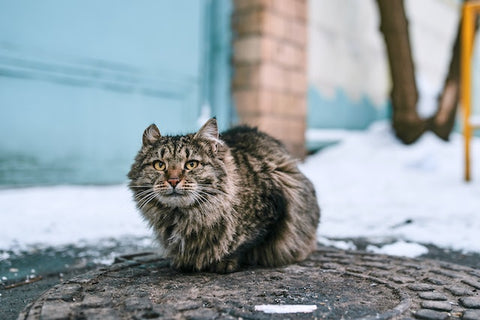Why do cats loaf?

Cats are reliably weird. You can read a dog’s mind from 100 yards, but cats can be hard to figure. Their behaviors can be puzzling (why do cats sit on paper?), frustrating beyond belief (why do cats yowl at night?), and sometimes, just plain adorable. The cat loaf falls into the last category.
If you think a cat loaf is cute, you’re not the only one. There’s an entire subreddit dedicated to this particular cat behavior (go on: click and get your fill), a kitty loaf website that features a Loaf of the Day, and even a private Facebook group called TUGGIN’!!!!!, which has some pretty strict rules around what constitutes an “acceptable” loaf.
Aw, heck. I even created a cat product called GingerLOAF House, because, well, it’s a cat thing. (You also purchase extra stickers for decorating, if you like to get fancy.)
A cat loaf by any other name…
At this point, you might be wondering what IS a cat loaf?
There’s a pretty good chance your cat does it, even if you don’t call it a loaf.
Maybe you call it cat bean, or cube cat, or turkey cat. You might call it hovercat, or potato cat, or sphinx cat (as in the mythical creature in Egyptian art, not as in Sphynx, the hairless cat breed). Kitty unit, tugboat, bread cat, and meatloaf, are not uncommon either.
Or maybe it’s more verb than noun to you, as in “Look! My cat is catloafing on the sofa again!”
Or maybe you don’t even have a name for this thing your cat does. But I know you think it’s cute.
So, what is a cat loaf?

Here’s where a picture is worth a thousand words. But I’ll try anyway.
A cat loaf is a particular cat sitting position. While loafing, a cat is sitting with belly to the ground (or whatever surface he is resting upon), and with his paws and tail tucked beneath him so that they all but disappear.

The effect is one of a cat with no appendages at all. In fact, a cat in this virtually rectangular shape, could be rightly compared to a loaf of sandwich bread.
Note that in a true cat loaf, the elbows of the forearms are touching ground, and the ankles are curled inward. Cats sometimes rest in a similar position, with their legs primly beneath them, but with the toe pads of all four legs on terra firma. This is a not a true cat loaf, and it likely means something different to the cat who has chosen to rest in this position, for reasons I’ll explain in a moment.
Variations on the cat-loaf theme
Cats, being cats, each add their own flair to the basic loaf. And the Internet, being the Internet, has turned each and every version of the loaf into a “thing.” Here are some notable cat-loaf interpretations, with extra points given for artistry and technique:
Partial loaf
You can see a bit of forearm or tail. Yes, I know I just said for a cat loaf to be a cat loaf, the appendages should be invisible, but cats do what they want. We’ll just call it something else.
Double or triple loaf
How many loafing cats can you fit into your iPhone viewfinder? If you’ve got more than one cat loafing within a few inches of another loafing cat, it’s practically like winning the lottery.
Face loaf
The rest of the cat is loafing as usual, but her face, which is normally upright and alert, is, instead, pressed against a surface. Her head might be smashed against the back of the sofa or chair she’s sitting on, or flopped over and smushed into the ground. “Face plant” would be the term we’d used to describe this position if you were doing it.
Loaf boat
A loaf boat is a loafing cat with one elbow slipped out from beneath him. From the front, that errant elbow appears to form the triangular bow of a boat.
Why, why, why do cats loaf?
If you’ve been reading my blog, you’ll know I rely on science for answers to our burning cat questions. But sometimes, we’re stuck with conjecture. Scientists have not yet studied this particular cat behavior, at least not to my knowledge.
Do cats loaf because their extremities get cold?
Do you tuck your cold hands into cozy pockets, or cross your arms and tuck your fingers into the warmth of your armpits?

Or perhaps, like me, you sit with your legs crossed, even on a chair or couch, when your toes are cold.
Human bodies, and likely cat bodies as well, are designed to favor the vital organs when it comes to temperature control.
When we’re cold, our bodies constrict the blood vessels in our hands and feet, directing more warm blood flow to our cores, preventing overall heat loss. Consequently, our hands and feet are the first body parts to feel cold when we are cold.[1]
We might assume that cats’ bodies conserve warmth in a similar way, directing blood flow away from their extremities – legs and tail – as well. They might, in the absence of pockets, be tucking their cooler parts beneath their warmer parts for comfort.
Do cats loaf because it’s comfortable?
You can look at a thousand photos of loafing cats (and I’ve come pretty close to that number while researching this post) and the one thing that comes across in all of them is that the cats look comfortable.

We humans fold our bodies in “strange” positions, too, often without thinking. We cross our arms and legs, for example. Some of us sit or stand with our hands braced behind our heads or necks. My sister and I do this weird thing with our wrists, often without even thinking about it.
There are all kinds of cultural interpretations about these positions and what they mean (crossed arms can be a “power pose,” say some), but for many of us, we contort our bodies in these ways because it feels good! Psychology Today says, “Ask someone…with their arms crossed if they are comfortable, and invariably they say yes, because they truly are.”[2]
Perhaps cats fold themselves into a loaf because it just feels good.
Why do cats look so relaxed when they’re loafing?

Cats have survived through the ages through a finely honed ability to assess danger and react quickly. Escape is most cats’ go-to response to potential danger. Most cats would rather run and hide from a threat, than fight.
The interesting thing about the loaf is that a cat in that position is not prepped for flight (or even fight). It might take an extra fraction of a second for a loafing cat to unfold herself, or expose a claw.
I think a cat who is loafing is revealing a little bit about his inner mindset: he’s at ease, he’s not stressed, anxious, or feeling unsafe. He’s not expecting to have to leap to attention any time in the near future.
You’ve created that safe world for your cat. Go on and pat yourself on the back.
The semi-loaf, quasi-loaf, half-loaf, or semi-unit

There’s another loaf-like position I described above, in which a cats’ four paws are on the ground.
The paws are still beneath the body, but the ankles aren’t folding inward and the pads are floor-facing. Some call this position the semi-loaf, quasi-loaf, half-loaf, or semi-unit.
A cat in this position appears to resting, and may want to keep her toesies toasty, but she’s ready to leap at a moment’s notice. She’s not as relaxed as a fully catloafing kitty would be.
But she’s still cute.
Rarely, a semi-loaf reflects a cat in pain

Cats, being prey to larger animals, as well as predators themselves, are very good at masking pain.
Rarely, the hunched position, with paws tucked in beneath the body, is a sign of pain rather than relaxation.
If your cat is otherwise alert, active, eating, and peeing and pooping normally, then the semi-loaf is likely just a semi-loaf.
But read this post on the signs your cat might be sick and then ask yourself these questions:
- Is your cat vocalizing more or less than normal?
- Is your cat peeing or pooping outside the litter box?
- Is your cat sleeping more than normal?
- Is your cat eating normally?
- Is your cat hissing or showing other signs of aggression, like biting or growling?
- Is your cat grooming excessively, or not at all?
- Is your cat purring for no apparent reason?
- Is your cat walking stiffly or limping?
- Is your cat staring vacantly?
If there are any other signs that something is not right with your cat, consider the semi-loaf a warning, and call your vet.
Love Pinterest? Here's a Pinterest-friendly pin for your boards!

Dawn LaFontaine
Dawn LaFontaine is a lifelong animal lover who always seems to have a little pet hair in her keyboard. Her blog, Kitty Contemplations, helps cat guardians better understand and care for the special beings they share their lives and homes with. Her cat-products business, Cat in the Box, sells beautiful, well-made, and award-winning products that she designed to meet the biological needs of cats.
_______________
FOOTNOTES
[1] Hecht, Marjorie. “Cold Feet and Hands: What to Do and Causes.” Healthline, Healthline Media, 1 Apr. 2019, https://www.healthline.com/health/cold-feet-and-hands.
[2] “9 Truths Exposing a Myth about Body Language.” Psychology Today, Sussex Publishers, https://www.psychologytoday.com/us/blog/spycatcher/201410/9-truths-exposing-myth-about-body-language.

